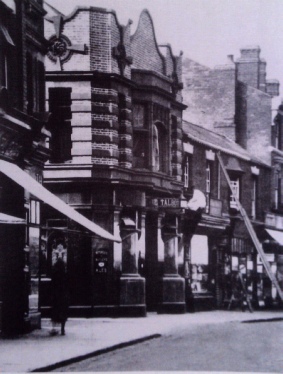

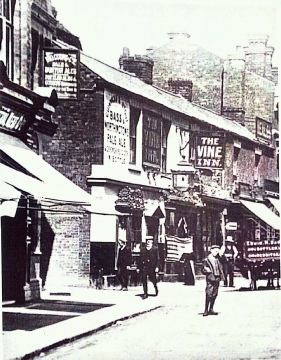
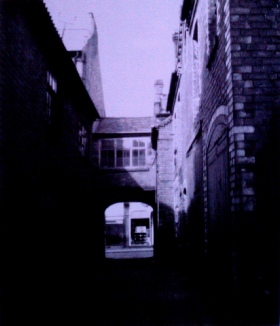
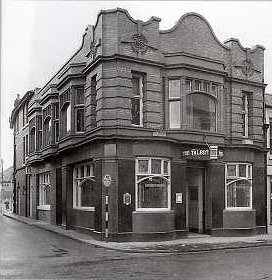

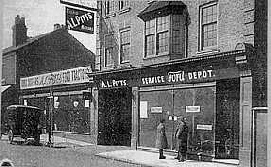
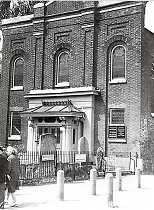
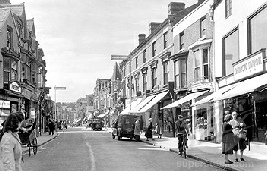
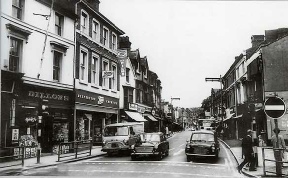
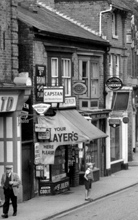
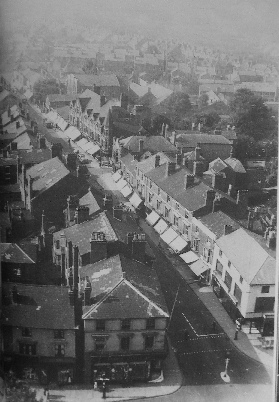
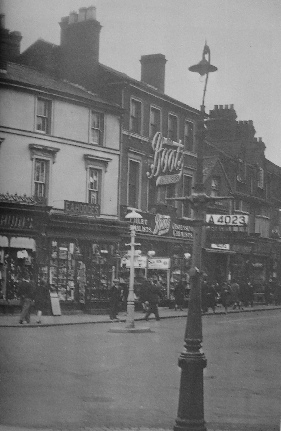
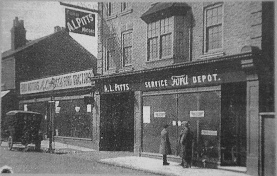
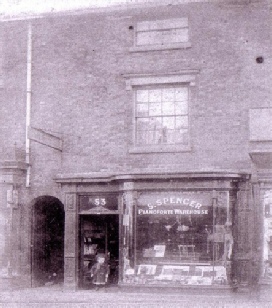
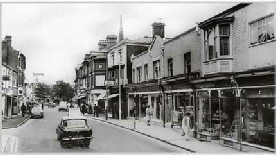

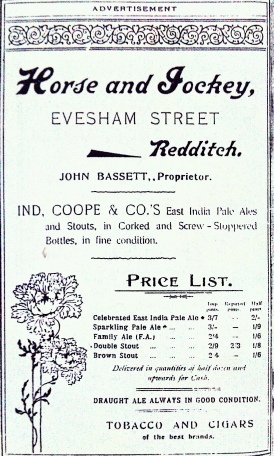

Source:
Reproduced from Anne Bradford's book “Old Redditch Voices”
Anne Bradfdord’s book “Old Redditch Voices” is a must read volume for anyone with an interest in the history of Redditch.
We are indebted to Anne, and all the people who helped her compile the book, for their permission to use this extract.
Anne Bradfdord’s book “Old Redditch Voices” is a must read volume for anyone with an interest in the history of Redditch.
We are indebted to Anne, and all the people who helped her compile the book, for their permission to use this extract.
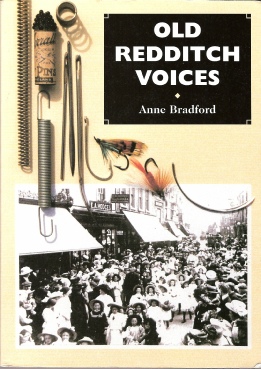
The Great South Road, a Toll Road, was built in 1826 and went straight through the centre of the town. Local folk say that Evesham Street was initially all private houses, some with gardens shop fronts were added later. As time progressed more and more shops opened and up until the 1960's it was one of the key retail and commercial areas of the town. When it was decided by the Development Corporation to redevelop the town centre as part of the new town development Evesham Street was one of the casualties, much being demolished to make way for the Kingfisher development.
Evesham Street is remembered by older Redditch citizens and Evesham Square and Evesham Mews in the Kingfisher Centre have been named after it.
Some of the history and memories of old Evesham Street are given in the following paragraphs. These have been taken from Anne Bradford's book, Old Redditch Voices.
Mike Kettle knew Evesham Street in the 1930's:
"Evesham Street was quite a place when I was a young lad. The Hungry Man pub was on one side of the top corner while on the far side, just above the old Congregational Church, was Pitts garage. My dad worked there for a short time when he first started work. It was the Congregational churchyard that had to be demolished when the Redditch Development Corporation built the Kingfisher Centre. On the other side was Samuel Milwards Pork Butcher's. He used to stand outside the shop with his straw hat and striped butcher's apron. He was a very jovial man, everybody liked him. Mr Millard was an extremely big man and his wife Constance, was very small and wispy, she was quite a musical person. They lived in a large house on the corner of Salop Road and Oakly Road. On the other side was Hollington's General Stores, then Heaphy's the Men's Outfitters. Just above the top of Evesham Street where the hill started, was a bakery. The owners (the Williams) were friends of my family and they let us stand in the upstairs rooms to watch the carnival when it passed by"
Evesham Street was full of pubs. According to Old Redditch Pubs in this short road were The Butler's Beerhouse, The Printer's Arms, The Horse and Jockey The Vine Inn (later The Talbot, The White Swan, The Pointer's (later The Royal George), The Turf, The Fleece, The Fountain Inn, The Hungry Man, The Old Briton, The Golden Salmon and The Plough and Harrow.
Set among the pubs was a Congregational Chapel, when it was built in 1827 the main entrance was from Vine Street. It had a little rose garden at the front in Evesham Street and a cemetery the back. The United Free Methodists had a chapel at the junction of Evesham Street and Ludlow Road, which became the 'Step Out, Drop In' centre. A police station and a court were built in Evesham Street in 1864 but they later moved to Church Road.
The 1871 census lists less than 20 shops in Evesham Street but by 1881 this had increased to over 40. Among the shops were six drapers (who often sold furniture and furnishing as well as clothes), five butchers, three bakers, three bookmakers, two grocers, two watch and clockmakers two milk sellers (one was a farmer), a corn merchant, a harness maker a bookmaker, and a tobacconist.
One of the retailers who continued for years was F W Hollington & Co the drapers. The Hollington’s were related to the Webb family of Webb's House. F. W. Hollington opened his shop in 1833. He was the owner of the gasworks having bought them from Thomas Mees (or Meece). He also owned a farm at Clent and often walked there, starting at four o'clock in the morning! Mary Allport says that her grandmother went one day to Hollingtons, or somewhere nearby, to buy some calico to make knickers
She said to the shopkeeper "Will it wear well" He shouted to his wife”, “Mary forward with your drawers” so she came into the shop and lifted her skirt to demonstrate the hard wearing qualities of the material.
Other long term retailers in Evesham Street were Thomas Haines tailor and outfitter, founded in 1881, S. London & Sons who were one of the first grocers, they began in 1871 and were related to Haines. Walter Humphries the shoemaker; Edward Ashford Hodges, printer stationer and member of the British and Foreign Bible Society; William Moule the Chemist, founded in 1881; and Moses Cranmores which started in 1871 as a drapers and boot and shoe store. It became Cranmore Simmonds and in 1907 went into furniture and upholstery.
Among these early shops were about ten families involved in needle-making. From the 1880's to the 1920's Emma and May Thomas, relatives of the Thomas's in British Mills, had a shop at 17 Evesham Street. They made and sold sail palms, a heavy leather type of glove which fitted over the palm so that the wearer could push needles through heavy fabric such as the material used for sails of boats. They also sold wools and other handicrafts.
Biggs Greengrocer must have been at 47 Evesham Street for half of the twentieth century . Mr. Biggs married a delightful dancer who held dance classes for children from three upward in halls right across Redditch until she was well past retirement age. She booked the Palace theatre once a year for a performance of all her students.
Mrs. Dorothy Butler who in 2005, was in her eighties and whose relatives ran the post office and the Fox and Goose at Foxlydiate remembers.
“My great ambition, when I was about nine years old, was to be the cashier at George Mason's grocery shop in Evesham Street. Her cubicle was raised up from the ground floor and the customers' bills and money whizzed along wires to her desk. She would uncouple the container and quickly send back the change and receipt. On her desk were two large spikes; the pink tickets from the bacon and dairy side of the shop were on one, the green from the grocery side on the other spike. I thought the whole procedure fascinating"
Another elderly resident says:
“Until well into the 1950's all the shops specialised in a particular product and didn't sell across a range as they do today, for example, a tobacconist didn't dream of selling food. The only exception came in later years and was Woolworth's situated where Tony's Handyman is now (Sadly closed in 2011 - ed). Even the Co-operative store usually only sold groceries. The Co-op was the originator of the points system. With each purchase you had tiny squares of paper, each one was a point and you stuck them in your divi (short for dividend) book until it was full. Then you could reclaim it for cash or goods"
One of the oldest shops in Redditch, Heaphy's Mens & Boys Wear is still surviving and going from strength to strength. The 1871 census describes George Heaphy as having been born 'between England and Scotland on the sea' .
Heaphy's began in trouble-torn Ireland more than 200 years ago. The Heaphy family lived in the Waterford area in Ireland but because of the troubles they moved to England and settled in Plymtree, in Devon where Thomas was born in 1787.
Thomas worked as a packman. His eldest son, also Thomas, arrived in 1808 and George followed four years later. Thomas Senior died when he was only 42, but his two sons carried on with the business. The womenfolk made woolen under-garments, cotton shirts and shirts and during the summer months the two brothers walked northwards with their donkey selling these goods, together with ribbons, cottons, needles etc. From Plymtree they would go through Taunton, Bridgewater, Glastonbury, Bath, the Cotswolds, Nailsworth, Stroud, Cheltenham, Evesham and Alcester to Redditch, buying needles at Alcester. In 1830 tragedy struck at Redditch. The were going “up the stones” (as the bottom of Mount Pleasant was called in those days) when their faithful donkey dropped dead from a heart attack. Unfortunately this was their most northerly port of call. The two brothers decided to split the stock, and Thomas returned to Devon while George settled in Redditch.
In 1831 during the time of William IV. George Heaphy set up a stall in the Redditch Shambles. The Shambles was an unadopted road leading from the main Evesham Road, it was later demolished and part of the Kingfisher Shopping Centre has been built on the site. He survived the cholera epidemic of 1832 and in 1841 married Miss Margaret Bashford, from Glastonbury the daughter of a draper with a corner shop. George Junior was born in 1842.
When the Shambles were demolished in 1861, George Senior and George Junior decided to open a shop in Evesham Street. Business flourished, and in 1876, they took over old stables on the corner of Walford Street and New Street and converted it into a shop, selling bed linen and ladies' clothes. It was so popular that in 1893 they closed the shop in Evesham Street and expanded their New Street shop.
George Senior and George Junior were both honest, hard-working Christians, regularly attending the congregations Church. Poor families were given clothing coupons by the Rector of Saint Stephen's for them to exchange at Heaphy's for overcoats and warm clothing. The family sometimes worked until the early hours but at midnight on Saturday night it was company policy that everyone laid down their tools. No-one was allowed to work on a Sunday.
George Junior was very friendly with Mr. Morris who owned the grocer's shop opposite. One afternoon, they were out together and they happened to pass a large barn south of Alcester. Two painters were supposed to be tarring the barn but they were fast asleep in the sun. Tip-toeing up to the sleeping painters, the two businessmen grabbed the brushes and a pot of tar. Mr Heaphy wrote in large letters on the front of the barn, “Wear Heaphy's Trousers” while Mr. Morris wrote, "Drink Morris's Tea'. The graffiti was clearly visible from the road and was only removed in the late 1980's.
George Jnr. and his wife, Sarah, had six children, three boys and three girls. Sarah died when their eldest son, Fritz, was only twelve. He promised his mother that he would look after the girls and he did, assisted by a housekeeper until one of the daughters, Tot, was old enough to run the household. Apparently, Tot ruled with a strict hand, insisting on a strict regime and not allowing any lax behaviour.
By the time George Jnr. died in 1899 the company making regular deliveries as far afield as Handsworth and Weatheroak, Fritz took over the company and although they had purchased a little game cart from Hewell Grange the previous year Fritz made most of the deliveries on his bicycle. Fritz was very popular with the ladies, he would visit a different female friend each evening: during the week taking a piece of fish, and the lady would cook it for him. However, he remained a bachelor.
At the height of the 1930's depression, Cyril Nash joined the company. Fritz was wearing old-fashioned clothes and Mr Nash taught him how to dress. The shop was redesigned and extended and the basement converted into a showroom.
One day, a policeman called in at the shop for a chat, and said to Cyril "Have you seen the smasher that's just started at Huins shoe shop?” so Cyril called in at Huins for a pair of shoelaces to view the new arrival. A Few days later, the 'smasher', Margot went to the local cinema on her own. Cyril seized his opportunity and sat next to her. From there, the romance blossomed and they were married in 1935. Cyril took over the company on Fritz's death in 1952 , and Margot Nash , who was company director for 39 years, now takes up the story:
"When my husband started at the company they supplied boys and girls clothing for 37 local Redditch schools. Thirteen thousand price tags were sewn on to garments by hand. There were displays at every school with the new intake when all the stock and props had to be carried from school to school. In 1936 the company was joined by Mr Farr who stayed with us until he retired.
“Everything was bought several months before the season. Trousers and knitwear for the autumn would be bought in the spring term. With all the schools, it would be blazers, tunics, gym tunics, summer dresses and trousers. You had to estimate what you would sell. It was all very exciting. We had our records to look back on but the great thing was experience, with some intuition. If anything was left we would have a summer sale but that wasn't important to us financially, our stock was so well-run. Cyril used to say that stock well-kept is stock well sold. Everything was bought from the manufacturer, we measured for suits and we bought in socks, ties, working overalls and all the Christmas things such as boxes of hankerchieves. However I wouldn't like to go into today's fashion wear."
“I loved my cash books, ledgers and journals. I also did the wages. Everything was done by hand. I remember my first adding machine, I thought it was marvelous.'
'Before the war most shops would open until 7 o'clock on weekdays, 8 o'clock on a Friday and 9 o'clock on a Saturday. When the war was on we had to finish much earlier, the war had an effect on the closing times. Most towns used to have Wednesday half day, today we are open all the week and sometimes on Sundays.
'We moved from our old shop in New Street into the Kingfisher Centre when it opened in about 1973 We watched the builders knock down the old premises in New Street. The funny thing was that the builders had found a consignment of old red school caps. There they were, knocking the premises down all wearing these red caps.
"In 1964 Cyril bought a little shop on Church Green West. It had belonged to Mr. Boyd, they had sold fancy goods and cameras. He said that it might come in useful one day. We eventually moved out of the Kingfisher Centre into this shop and have extended it into the first floor. Since then we have gone on to buy businesses in Warwick Rugby and Sutton Coldfield.
'Retail now is certainly very different to the old days. Then it was all over-the-counter. Now that people are traveling so much we have to diversify to progress. We are carrying much larger stocks which we change round to the different branches. lf an item doesn't sell in one branch we can send it to another.
'Our saving grace over the multiple firms and big boys is the service that we give, of which we are very proud. in the large stores people just go along and see rails of clothes and they have to serve themselves. I see service in the main as helping people in their purchases. Also as a smaller company you can take an interest in the locality and get involved in whatever is going on in your town or wherever you are. Over the years I have held a variety of offices in the Mothers' Union, the WI, Redditch Ladies' Circle, the Inner Wheel. and other societies. We have always taken an interest in Redditch, now we are starting to do it elsewhere. Recently, our staff took part in a raft race which finished at Stratford-on-Avon opposite the theatre. and we had a picnic there.
'I take a Keep Fit class in Redditch for the elderly, I still go swimming and until recently I played golf, now I play bridge. I have two children seven grandchildren and eleven great-grandchildren. I am very interested in life and I have loved every minute"
Bob Brown has fond memories of the Elcador Cafe of the early 1960's:
''It was at the top of Evesham Street, opposite the Liberal Club and slightly down the hill probably on the site of the Prudential offices and Derek Youngs, the accountants. The Elcador was owned by Italians. It was long and narrow with a little serving counter at the far end. There were about twelve tables I can remember the tables were highly varnished slices of wood from tree trunks - they were oval in shape and the bark had been left round the edge.
'From the early to the mid 1960's this was the IN place for teenagers to go. We weren't old enough to drink and we wanted somewhere to meet. There were other cafes but this was the most popular. It was really just a snack bar, they did beefburgers and sandwiches but the most popular, and my favourite, was a bacon bap with melted cheese. They served tea and coffee and we mostly drank coffee. There was a wall-mounted jukebox - that was very modern in those days - and you could smoke, I used to go there in the evenings and weekends when I was I 6 or 17 and sit and chat.
'This was the time of the Mods and Rockers. Because I had a motor bike, I was a Rocker. I used to park it outside the Elcador. I wore a black leather jacket, black gloves and although crash helmets were not compulsory, I wore a blue crash helmet with goggles. It was all part of the image. You could buy chequered tape from Halfords and decorate your helmet. It you took a girl on the back of your bike she didn't wear a helmet as most girls wore their hair on top. The Mods used to wear suits and top hats like the old trilbys, and they used to carry a slim walking stick. They looked very posh although they were probably no better off financially than the Rockers, in fact Mods and Rockers often worked side by side. The Mods usually travelled about in public transport, very few people under 21 had a car.
'The Mods came into the cafe as well as the Rockers. There was very little trouble between us, perhaps there might have been one or two skirmishes but on the whole we were very friendly.
'Redditch was a lovely town although you didn't realise it at the time. It was full of life for teenagers. There were dances at the Talbot in Evesham Street every Tuesday, while on a Friday evening Rock and Roll dancing took place at the Warwick Arms in Ipsley Street - it's still there on the opposite corner to Millsbro House. From the age of 18 our big night out was on a Saturday night. We would meet at the Unicorn on Unicorn Hill, which was the most popular pub at that time, then we would go to Hopwood Caravan Club for the main dance of the week. Redditch had two cinemas, the Danilo and the Gaumont, both widely used. If you took a girl out for the first time you usually took her to the cinema. It wasn't like the multiscreen cinemas of today, you only had the one film showing. However, on a Sunday night and a Monday night they would show a different film for a bit of variety so that you could see more than one film in a week.
'Of course, as teenagers we occasionally used to sneak into pubs but if you were caught you were in serious trouble with both the police and your parents. It's not like today. If you had the cane at school your parents would want to know what you had had it for and you were likely to get it again at home!
“Unemployment in the town was very low, there were a lot of small engineering companies and I worked at one of them. In 1961 I was earning £3 a week I gave my mother £2 and kept £1. You could have a good Saturday night out on ten shillings (50p). My first record player in 1962 cost £l7 - it took me about six months to save up for that. As I got to 18 I was earning about £8 or £9 a week. I used to save in a post office savings account, 10 shillings (50p) or 5 shillings (25p) a week. My first bike cost me £65, bought from Curly Rogers and his father who had a shop at the end of Clive Road, opposite the old Railway pub. Most of us had money to spare in our pockets.”
Off Evesham Street was Worcester Road, one of the roads which has completely disappeared. It ran from the Evesham Road downhill towards the station parallel with Unicorn Hill Originally it was a cul-de-sac known as (Red Cow Yard) as it ended in the yard of the Red Cow. A few cottages were dotted around. The pub was one of the oldest in Redditch . It sold a very strong beer, 'Black Strap' (although strong, it was better than the local water) and in Old Redditch Pubs there are rumours of strange orgies. George Smallwood from Smethwick arrived at the pub in 1835 and when he died in 1861 his widows became licensee. The pub closed in about 1870. Meanwhile, The Vine had been built on the corner of Evesham Street and as the Red Cow declined, so The Vine flourished. Red Cow Yard became Vine Street in about 1860. In 1925 the Vine was demolished becoming The Talbot. By this time, the road went through to the Bromsgrove Road and had been renamed 'Worcester Road'.
By a strange coincidence a Temperance Hall was built on the site of the Red Cow. The Temperance Hall became the Kingfisher Hall. The name of the new shopping centre, the Kingfisher Centre was partly inspired by the hall, but properly, the Redditch Development Corporation should have chosen the original name of the site, so that, instead of the Kingfisher Centre we should now have "The Red Cow Centre".
Evesham Street is remembered by older Redditch citizens and Evesham Square and Evesham Mews in the Kingfisher Centre have been named after it.
Some of the history and memories of old Evesham Street are given in the following paragraphs. These have been taken from Anne Bradford's book, Old Redditch Voices.
Mike Kettle knew Evesham Street in the 1930's:
"Evesham Street was quite a place when I was a young lad. The Hungry Man pub was on one side of the top corner while on the far side, just above the old Congregational Church, was Pitts garage. My dad worked there for a short time when he first started work. It was the Congregational churchyard that had to be demolished when the Redditch Development Corporation built the Kingfisher Centre. On the other side was Samuel Milwards Pork Butcher's. He used to stand outside the shop with his straw hat and striped butcher's apron. He was a very jovial man, everybody liked him. Mr Millard was an extremely big man and his wife Constance, was very small and wispy, she was quite a musical person. They lived in a large house on the corner of Salop Road and Oakly Road. On the other side was Hollington's General Stores, then Heaphy's the Men's Outfitters. Just above the top of Evesham Street where the hill started, was a bakery. The owners (the Williams) were friends of my family and they let us stand in the upstairs rooms to watch the carnival when it passed by"
Evesham Street was full of pubs. According to Old Redditch Pubs in this short road were The Butler's Beerhouse, The Printer's Arms, The Horse and Jockey The Vine Inn (later The Talbot, The White Swan, The Pointer's (later The Royal George), The Turf, The Fleece, The Fountain Inn, The Hungry Man, The Old Briton, The Golden Salmon and The Plough and Harrow.
Set among the pubs was a Congregational Chapel, when it was built in 1827 the main entrance was from Vine Street. It had a little rose garden at the front in Evesham Street and a cemetery the back. The United Free Methodists had a chapel at the junction of Evesham Street and Ludlow Road, which became the 'Step Out, Drop In' centre. A police station and a court were built in Evesham Street in 1864 but they later moved to Church Road.
The 1871 census lists less than 20 shops in Evesham Street but by 1881 this had increased to over 40. Among the shops were six drapers (who often sold furniture and furnishing as well as clothes), five butchers, three bakers, three bookmakers, two grocers, two watch and clockmakers two milk sellers (one was a farmer), a corn merchant, a harness maker a bookmaker, and a tobacconist.
One of the retailers who continued for years was F W Hollington & Co the drapers. The Hollington’s were related to the Webb family of Webb's House. F. W. Hollington opened his shop in 1833. He was the owner of the gasworks having bought them from Thomas Mees (or Meece). He also owned a farm at Clent and often walked there, starting at four o'clock in the morning! Mary Allport says that her grandmother went one day to Hollingtons, or somewhere nearby, to buy some calico to make knickers
She said to the shopkeeper "Will it wear well" He shouted to his wife”, “Mary forward with your drawers” so she came into the shop and lifted her skirt to demonstrate the hard wearing qualities of the material.
Other long term retailers in Evesham Street were Thomas Haines tailor and outfitter, founded in 1881, S. London & Sons who were one of the first grocers, they began in 1871 and were related to Haines. Walter Humphries the shoemaker; Edward Ashford Hodges, printer stationer and member of the British and Foreign Bible Society; William Moule the Chemist, founded in 1881; and Moses Cranmores which started in 1871 as a drapers and boot and shoe store. It became Cranmore Simmonds and in 1907 went into furniture and upholstery.
Among these early shops were about ten families involved in needle-making. From the 1880's to the 1920's Emma and May Thomas, relatives of the Thomas's in British Mills, had a shop at 17 Evesham Street. They made and sold sail palms, a heavy leather type of glove which fitted over the palm so that the wearer could push needles through heavy fabric such as the material used for sails of boats. They also sold wools and other handicrafts.
Biggs Greengrocer must have been at 47 Evesham Street for half of the twentieth century . Mr. Biggs married a delightful dancer who held dance classes for children from three upward in halls right across Redditch until she was well past retirement age. She booked the Palace theatre once a year for a performance of all her students.
Mrs. Dorothy Butler who in 2005, was in her eighties and whose relatives ran the post office and the Fox and Goose at Foxlydiate remembers.
“My great ambition, when I was about nine years old, was to be the cashier at George Mason's grocery shop in Evesham Street. Her cubicle was raised up from the ground floor and the customers' bills and money whizzed along wires to her desk. She would uncouple the container and quickly send back the change and receipt. On her desk were two large spikes; the pink tickets from the bacon and dairy side of the shop were on one, the green from the grocery side on the other spike. I thought the whole procedure fascinating"
Another elderly resident says:
“Until well into the 1950's all the shops specialised in a particular product and didn't sell across a range as they do today, for example, a tobacconist didn't dream of selling food. The only exception came in later years and was Woolworth's situated where Tony's Handyman is now (Sadly closed in 2011 - ed). Even the Co-operative store usually only sold groceries. The Co-op was the originator of the points system. With each purchase you had tiny squares of paper, each one was a point and you stuck them in your divi (short for dividend) book until it was full. Then you could reclaim it for cash or goods"
One of the oldest shops in Redditch, Heaphy's Mens & Boys Wear is still surviving and going from strength to strength. The 1871 census describes George Heaphy as having been born 'between England and Scotland on the sea' .
Heaphy's began in trouble-torn Ireland more than 200 years ago. The Heaphy family lived in the Waterford area in Ireland but because of the troubles they moved to England and settled in Plymtree, in Devon where Thomas was born in 1787.
Thomas worked as a packman. His eldest son, also Thomas, arrived in 1808 and George followed four years later. Thomas Senior died when he was only 42, but his two sons carried on with the business. The womenfolk made woolen under-garments, cotton shirts and shirts and during the summer months the two brothers walked northwards with their donkey selling these goods, together with ribbons, cottons, needles etc. From Plymtree they would go through Taunton, Bridgewater, Glastonbury, Bath, the Cotswolds, Nailsworth, Stroud, Cheltenham, Evesham and Alcester to Redditch, buying needles at Alcester. In 1830 tragedy struck at Redditch. The were going “up the stones” (as the bottom of Mount Pleasant was called in those days) when their faithful donkey dropped dead from a heart attack. Unfortunately this was their most northerly port of call. The two brothers decided to split the stock, and Thomas returned to Devon while George settled in Redditch.
In 1831 during the time of William IV. George Heaphy set up a stall in the Redditch Shambles. The Shambles was an unadopted road leading from the main Evesham Road, it was later demolished and part of the Kingfisher Shopping Centre has been built on the site. He survived the cholera epidemic of 1832 and in 1841 married Miss Margaret Bashford, from Glastonbury the daughter of a draper with a corner shop. George Junior was born in 1842.
When the Shambles were demolished in 1861, George Senior and George Junior decided to open a shop in Evesham Street. Business flourished, and in 1876, they took over old stables on the corner of Walford Street and New Street and converted it into a shop, selling bed linen and ladies' clothes. It was so popular that in 1893 they closed the shop in Evesham Street and expanded their New Street shop.
George Senior and George Junior were both honest, hard-working Christians, regularly attending the congregations Church. Poor families were given clothing coupons by the Rector of Saint Stephen's for them to exchange at Heaphy's for overcoats and warm clothing. The family sometimes worked until the early hours but at midnight on Saturday night it was company policy that everyone laid down their tools. No-one was allowed to work on a Sunday.
George Junior was very friendly with Mr. Morris who owned the grocer's shop opposite. One afternoon, they were out together and they happened to pass a large barn south of Alcester. Two painters were supposed to be tarring the barn but they were fast asleep in the sun. Tip-toeing up to the sleeping painters, the two businessmen grabbed the brushes and a pot of tar. Mr Heaphy wrote in large letters on the front of the barn, “Wear Heaphy's Trousers” while Mr. Morris wrote, "Drink Morris's Tea'. The graffiti was clearly visible from the road and was only removed in the late 1980's.
George Jnr. and his wife, Sarah, had six children, three boys and three girls. Sarah died when their eldest son, Fritz, was only twelve. He promised his mother that he would look after the girls and he did, assisted by a housekeeper until one of the daughters, Tot, was old enough to run the household. Apparently, Tot ruled with a strict hand, insisting on a strict regime and not allowing any lax behaviour.
By the time George Jnr. died in 1899 the company making regular deliveries as far afield as Handsworth and Weatheroak, Fritz took over the company and although they had purchased a little game cart from Hewell Grange the previous year Fritz made most of the deliveries on his bicycle. Fritz was very popular with the ladies, he would visit a different female friend each evening: during the week taking a piece of fish, and the lady would cook it for him. However, he remained a bachelor.
At the height of the 1930's depression, Cyril Nash joined the company. Fritz was wearing old-fashioned clothes and Mr Nash taught him how to dress. The shop was redesigned and extended and the basement converted into a showroom.
One day, a policeman called in at the shop for a chat, and said to Cyril "Have you seen the smasher that's just started at Huins shoe shop?” so Cyril called in at Huins for a pair of shoelaces to view the new arrival. A Few days later, the 'smasher', Margot went to the local cinema on her own. Cyril seized his opportunity and sat next to her. From there, the romance blossomed and they were married in 1935. Cyril took over the company on Fritz's death in 1952 , and Margot Nash , who was company director for 39 years, now takes up the story:
"When my husband started at the company they supplied boys and girls clothing for 37 local Redditch schools. Thirteen thousand price tags were sewn on to garments by hand. There were displays at every school with the new intake when all the stock and props had to be carried from school to school. In 1936 the company was joined by Mr Farr who stayed with us until he retired.
“Everything was bought several months before the season. Trousers and knitwear for the autumn would be bought in the spring term. With all the schools, it would be blazers, tunics, gym tunics, summer dresses and trousers. You had to estimate what you would sell. It was all very exciting. We had our records to look back on but the great thing was experience, with some intuition. If anything was left we would have a summer sale but that wasn't important to us financially, our stock was so well-run. Cyril used to say that stock well-kept is stock well sold. Everything was bought from the manufacturer, we measured for suits and we bought in socks, ties, working overalls and all the Christmas things such as boxes of hankerchieves. However I wouldn't like to go into today's fashion wear."
“I loved my cash books, ledgers and journals. I also did the wages. Everything was done by hand. I remember my first adding machine, I thought it was marvelous.'
'Before the war most shops would open until 7 o'clock on weekdays, 8 o'clock on a Friday and 9 o'clock on a Saturday. When the war was on we had to finish much earlier, the war had an effect on the closing times. Most towns used to have Wednesday half day, today we are open all the week and sometimes on Sundays.
'We moved from our old shop in New Street into the Kingfisher Centre when it opened in about 1973 We watched the builders knock down the old premises in New Street. The funny thing was that the builders had found a consignment of old red school caps. There they were, knocking the premises down all wearing these red caps.
"In 1964 Cyril bought a little shop on Church Green West. It had belonged to Mr. Boyd, they had sold fancy goods and cameras. He said that it might come in useful one day. We eventually moved out of the Kingfisher Centre into this shop and have extended it into the first floor. Since then we have gone on to buy businesses in Warwick Rugby and Sutton Coldfield.
'Retail now is certainly very different to the old days. Then it was all over-the-counter. Now that people are traveling so much we have to diversify to progress. We are carrying much larger stocks which we change round to the different branches. lf an item doesn't sell in one branch we can send it to another.
'Our saving grace over the multiple firms and big boys is the service that we give, of which we are very proud. in the large stores people just go along and see rails of clothes and they have to serve themselves. I see service in the main as helping people in their purchases. Also as a smaller company you can take an interest in the locality and get involved in whatever is going on in your town or wherever you are. Over the years I have held a variety of offices in the Mothers' Union, the WI, Redditch Ladies' Circle, the Inner Wheel. and other societies. We have always taken an interest in Redditch, now we are starting to do it elsewhere. Recently, our staff took part in a raft race which finished at Stratford-on-Avon opposite the theatre. and we had a picnic there.
'I take a Keep Fit class in Redditch for the elderly, I still go swimming and until recently I played golf, now I play bridge. I have two children seven grandchildren and eleven great-grandchildren. I am very interested in life and I have loved every minute"
Bob Brown has fond memories of the Elcador Cafe of the early 1960's:
''It was at the top of Evesham Street, opposite the Liberal Club and slightly down the hill probably on the site of the Prudential offices and Derek Youngs, the accountants. The Elcador was owned by Italians. It was long and narrow with a little serving counter at the far end. There were about twelve tables I can remember the tables were highly varnished slices of wood from tree trunks - they were oval in shape and the bark had been left round the edge.
'From the early to the mid 1960's this was the IN place for teenagers to go. We weren't old enough to drink and we wanted somewhere to meet. There were other cafes but this was the most popular. It was really just a snack bar, they did beefburgers and sandwiches but the most popular, and my favourite, was a bacon bap with melted cheese. They served tea and coffee and we mostly drank coffee. There was a wall-mounted jukebox - that was very modern in those days - and you could smoke, I used to go there in the evenings and weekends when I was I 6 or 17 and sit and chat.
'This was the time of the Mods and Rockers. Because I had a motor bike, I was a Rocker. I used to park it outside the Elcador. I wore a black leather jacket, black gloves and although crash helmets were not compulsory, I wore a blue crash helmet with goggles. It was all part of the image. You could buy chequered tape from Halfords and decorate your helmet. It you took a girl on the back of your bike she didn't wear a helmet as most girls wore their hair on top. The Mods used to wear suits and top hats like the old trilbys, and they used to carry a slim walking stick. They looked very posh although they were probably no better off financially than the Rockers, in fact Mods and Rockers often worked side by side. The Mods usually travelled about in public transport, very few people under 21 had a car.
'The Mods came into the cafe as well as the Rockers. There was very little trouble between us, perhaps there might have been one or two skirmishes but on the whole we were very friendly.
'Redditch was a lovely town although you didn't realise it at the time. It was full of life for teenagers. There were dances at the Talbot in Evesham Street every Tuesday, while on a Friday evening Rock and Roll dancing took place at the Warwick Arms in Ipsley Street - it's still there on the opposite corner to Millsbro House. From the age of 18 our big night out was on a Saturday night. We would meet at the Unicorn on Unicorn Hill, which was the most popular pub at that time, then we would go to Hopwood Caravan Club for the main dance of the week. Redditch had two cinemas, the Danilo and the Gaumont, both widely used. If you took a girl out for the first time you usually took her to the cinema. It wasn't like the multiscreen cinemas of today, you only had the one film showing. However, on a Sunday night and a Monday night they would show a different film for a bit of variety so that you could see more than one film in a week.
'Of course, as teenagers we occasionally used to sneak into pubs but if you were caught you were in serious trouble with both the police and your parents. It's not like today. If you had the cane at school your parents would want to know what you had had it for and you were likely to get it again at home!
“Unemployment in the town was very low, there were a lot of small engineering companies and I worked at one of them. In 1961 I was earning £3 a week I gave my mother £2 and kept £1. You could have a good Saturday night out on ten shillings (50p). My first record player in 1962 cost £l7 - it took me about six months to save up for that. As I got to 18 I was earning about £8 or £9 a week. I used to save in a post office savings account, 10 shillings (50p) or 5 shillings (25p) a week. My first bike cost me £65, bought from Curly Rogers and his father who had a shop at the end of Clive Road, opposite the old Railway pub. Most of us had money to spare in our pockets.”
Off Evesham Street was Worcester Road, one of the roads which has completely disappeared. It ran from the Evesham Road downhill towards the station parallel with Unicorn Hill Originally it was a cul-de-sac known as (Red Cow Yard) as it ended in the yard of the Red Cow. A few cottages were dotted around. The pub was one of the oldest in Redditch . It sold a very strong beer, 'Black Strap' (although strong, it was better than the local water) and in Old Redditch Pubs there are rumours of strange orgies. George Smallwood from Smethwick arrived at the pub in 1835 and when he died in 1861 his widows became licensee. The pub closed in about 1870. Meanwhile, The Vine had been built on the corner of Evesham Street and as the Red Cow declined, so The Vine flourished. Red Cow Yard became Vine Street in about 1860. In 1925 the Vine was demolished becoming The Talbot. By this time, the road went through to the Bromsgrove Road and had been renamed 'Worcester Road'.
By a strange coincidence a Temperance Hall was built on the site of the Red Cow. The Temperance Hall became the Kingfisher Hall. The name of the new shopping centre, the Kingfisher Centre was partly inspired by the hall, but properly, the Redditch Development Corporation should have chosen the original name of the site, so that, instead of the Kingfisher Centre we should now have "The Red Cow Centre".